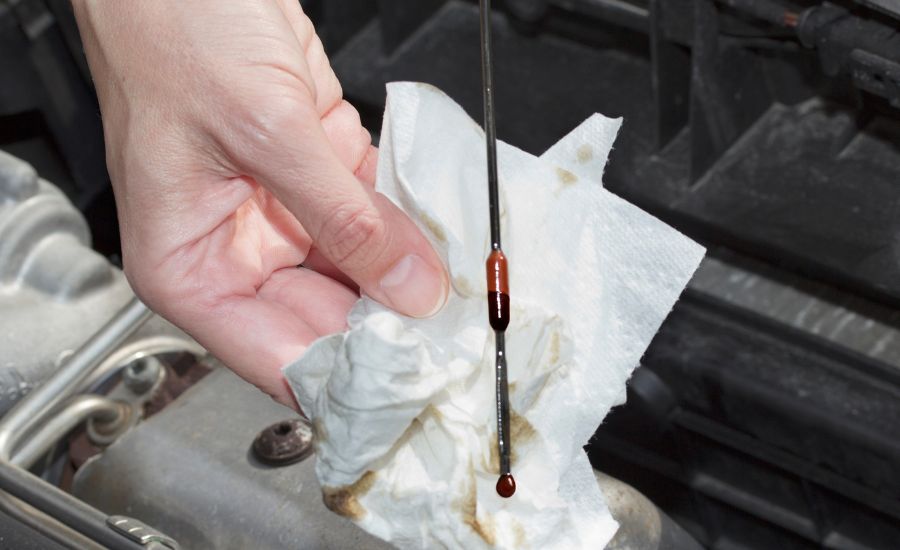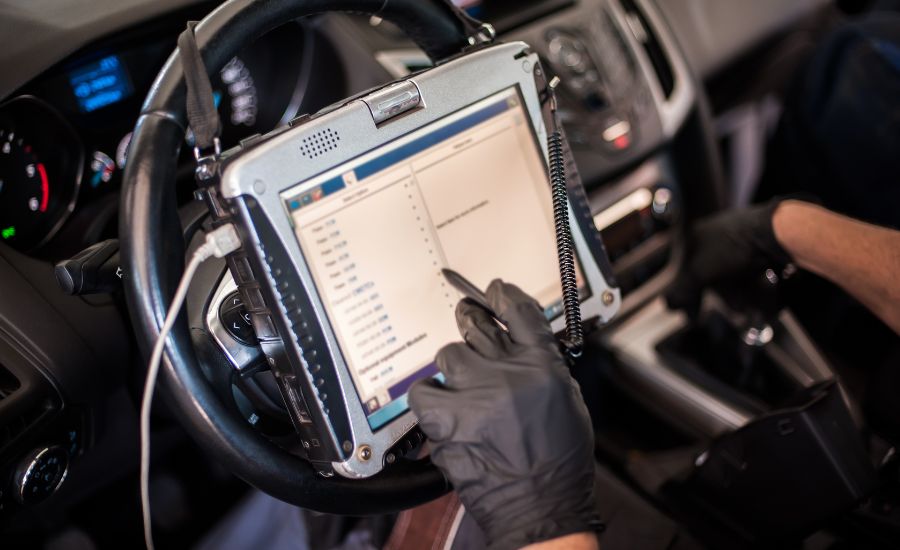How to fix transmission over temp Jeep Grand Cherokee? A Jeep’s performance is intricately tied to the smooth operation of its transmission system.
In the pages of this guide, we’ll delve into the world of addressing Jeep transmission temp and overheating in Jeep Grand Cherokee.

Contents
Jeep Grand Cherokee transmission over temp
When it comes to your Jeep’s transmission, maintaining the right operating temperature is crucial for its longevity and performance.
Factors contributing to transmission over temp
Various factors can contribute to transmission over temp, often exacerbated by the demanding tasks that Jeeps are designed to tackle.
Let’s delve into these factors and understand how they can lead to transmission over temp:
- Towing. The Jeep Grand Cherokee is renowned for its towing capabilities, but the increased workload generates additional heat, causing the transmission fluid to heat up more rapidly.
- Off-roading. This prolonged activity can lead to transmission over temp, especially when combined with limited airflow to the transmission.
- Heavy loads. Whether it’s transporting gear, equipment, or passengers, carrying a substantial load in your Jeep can lead to transmission over temp. The engine works harder to propel the added weight, generating excess heat.
Signs of an overheating transmission
Keep an eye out for the following symptoms of a high transmission temperature:
- Warning lights. Modern Jeeps are equipped with sensors that monitor various components, including transmission fluids and overheating transmission. If the system detects excessive heat, a warning light may illuminate the dashboard, indicating the need for immediate attention.
- Odd odors. An overheating Jeep Grand Cherokee transmission can produce a distinct burning smell. This odor arises when the transmission fluid exceeds its optimal temperature and begins to break down.
- Poor shifting. Jeep Grand Cherokee transmission overheating can lead to erratic or delayed gear shifts.
Diagnosing the issue
A systematic approach will help you identify the root problem and determine the appropriate course of action.
Check for warning signs
Begin by paying close attention to any warning lights on the dashboard. If the Jeep Grand Cherokee transmission temperature light is illuminated, it’s a clear indication of elevated temperatures.
Additionally, be attentive to any changes in your Jeep’s performance, such as unusual noises, rough shifting, or delayed engagement.
Perform a visual inspection
Open the hood and inspect the engine compartment for any visible signs of leaks, damage, or blockages around the transmission area.
Check for any loose or disconnected hoses, as these can affect cooling efficiency.
Use diagnostic tools
Modern Jeeps often come equipped with onboard diagnostic systems that can provide valuable information about your vehicle’s health.
If you have access to a diagnostic scanner, connect it to your Jeep’s OBD-II port to retrieve any trouble codes related to the transmission or temperature issues.
Check transmission fluid
Transmission fluid plays a crucial role in regulating temperature and ensuring smooth operation.
The fluid can overheat if the radiator isn’t functioning properly, which can lead to issues where the transmission begins to slip or attain the neutral or reverse phase.
Low transmission fluid is certain to cause the transmission over temp.
There is a significant likelihood that friction will worsen when you’ve got low transmission fluid.

Assess transmission cooler
The cooling system, including the transmission cooler, is essential for regulating transmission temp. Inspect the cooling lines and connections for leaks or damage.
If your Jeep Grand Cherokee is equipped with an external transmission cooler, ensure it’s clean and unobstructed by debris.
Review driving habits
Have you engaged in heavy towing, prolonged off-roading, or consistent stop-and-go traffic?
These habits can put extra strain on the transmission and contribute to overheating.
Monitor operating conditions
Pay attention to the temperature gauge on your dashboard while driving your Jeep Grand Cherokee.
If you notice the transmission over temp during specific activities, it can provide valuable insights into the cause of overheating.
Seek professional help
If the transmission over temp issue remains unresolved or if you’re uncertain about the situation, it’s wise to seek assistance from a certified mechanic.
Once you’ve narrowed down the potential causes, you can proceed with the appropriate solutions to restore the transmission of the Jeep Grand Cherokee to optimal working conditions.
Fixing transmission overheating: DIY solutions
Addressing transmission issues in your Jeep Grand Cherokee doesn’t always require a trip to the mechanic.
With the right know-how and some DIY efforts, you can implement effective solutions to restore optimal temperature regulation.
Upgrading the cooling system
- Installing an external cooling system
Consider adding aftermarket transmission coolers to enhance heat dissipation. These coolers help regulate fluid temperature and are especially beneficial for Jeeps engaged in towing or off-roading.
- Checking radiator condition
A compromised radiator can impact transmission cooling. Inspect the radiator for leaks, damage, or debris buildup that might obstruct airflow. Cleaning or repairing the radiator can improve overall cooling efficiency.
Servicing the transmission fluid
- Replacing old fluid
Over time, transmission fluid can deteriorate, losing its heat-absorbing and lubricating properties. Follow the maintenance schedule of your Jeep Grand Cherokee to ensure timely fluid changes, preventing fluid breakdown and overheating.
- Ensuring correct fluid levels
Maintaining the right fluid level is essential for efficient heat regulation. Follow your owner’s manual to check and adjust the transmission fluid level as needed.

Adjusting driving habits
- Proper gear selection
Opt for lower gears when climbing hills or navigating challenging terrains. This reduces strain on the transmission, preventing excessive heat buildup.
- Cooling down
Allow your Jeep Grand Cherokee to idle for a few minutes after towing or driving under heavy loads. This gives the transmission time to cool down before shutting off the engine.
Inspecting transmission lines and connections
- Looking for leaks
Regularly inspect transmission lines for signs of leakage. Leaks can lead to low fluid levels and decreased cooling effectiveness. Address any leaks promptly.
- Checking for blockages
Ensure that transmission cooling lines and connections are free from debris or blockages that could impede fluid flow. Clear any obstructions to maintain optimal cooling.
Monitoring transmission temperature
- Aftermarket temperature gauges
Consider installing an aftermarket transmission temperature gauge to monitor fluid temperature more closely. This can help you detect overheating issues early on.
Professional repairs and maintenance
While DIY solutions can address many overheating issues, there are times when seeking professional help is essential.
Complex problems and intricate transmission issues require the expertise of certified mechanics who specialize in diagnosing and repairing automotive systems.
Expert diagnosis
Certified mechanics possess in-depth knowledge of vehicle systems, including transmissions. They have access to specialized tools and diagnostic equipment that can pinpoint the exact cause of transmission overheating.
Their expertise ensures an accurate diagnosis, saving time and preventing unnecessary repairs.
Precision repairs
Transmission systems are intricate and delicate. Professional mechanics have the training and experience to perform precise repairs without causing further damage.
They can address complex issues, such as valve body malfunctions or torque converter problems, which might be beyond the scope of DIY repairs.
Preventing costly mistakes
Incorrect repairs can lead to costly consequences down the road. Professional mechanics not only fix the immediate issue but also prevent potential complications that could arise from improper repairs.
Their interventions can extend the lifespan of your transmission and help you avoid expensive future repairs.
Access to OEM parts
Certified mechanics have access to original equipment manufacturer (OEM) parts (such as the transmission temperature sensor for getting a transmission over temp message), ensuring that any replacement components meet the manufacturer’s specifications.
Using quality parts is vital for maintaining the integrity of your Jeep’s transmission system.
Warranty considerations
If your Jeep is under warranty, certain repairs should be performed by professionals to maintain the warranty’s validity.
Certified mechanics can ensure that repairs are carried out by warranty requirements.
Future maintenance recommendations
Professional mechanics can provide valuable insights into preventive maintenance strategies to keep your Jeep’s transmission running smoothly.
They can recommend maintenance schedules, fluid change intervals, and other measures to prevent future overheating issues.

Conclusion
Your Jeep’s transmission is a critical component that plays a pivotal role in its performance, whether you’re conquering off-road trails or navigating city streets.
Addressing the overheated transmission issue is essential to ensure smooth shifts, optimal power delivery, and a prolonged lifespan for your vehicle.
FAQ
What do you do when your transmission is over temperature?
If the check engine light is on, pull over to a safe location and let your Jeep idle to allow the transmission to cool down.
Turn off any unnecessary accessories that might contribute to the overheated transmission.
Check the transmission fluid level and condition, and ensure there are no visible leaks.
How do you fix a transmission temperature light?
If your transmission temperature warning light is illuminated, it indicates that the transmission fluid is running too hot, which can lead to many issues, including transmission slipping.
To fix this, start by following the steps mentioned earlier: pull over, let the Jeep idle, and assess the transmission fluid level and condition.
If the transmission fluid is low, add the appropriate type of transmission fluid to bring it to the recommended level.
What causes transmission temp to run high?
There could be several reasons why the transmission overheats, including:
1. Towing heavy loads or trailers
2. Engaging in prolonged off-road driving
3. Operating in extreme weather conditions
4. Clogged transmission filter
5. Low transmission fluid levels
6. Faulty transmission temperature sensor circuit
7. Faulty cooling system components, such as a malfunctioning radiator cooling automatic transmission fluid
8. Excessive strain due to poor driving habits or improper gear selection
9. Faulty solenoid regulating transmission pressure
What is the transmission temperature warning light on a Jeep Compass?
The transmission temp light on a Jeep Compass is an indicator that alerts you when the transmission fluid temperature is too high.
When the check engine light illuminates, take immediate action to prevent overheating and potential damage to the transmission.
Sometimes the neutral safety switch function is on the same wire leading to a false transmission over temp message about transmission problems.


